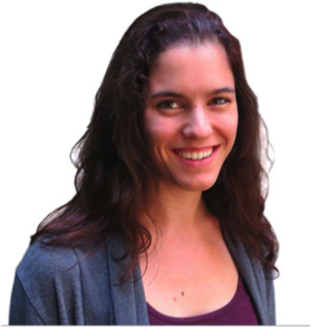Clausen, Caitlin
|
Caitlin Clausen is an Alumni of the Department of Chemistry and Biochemistry at the University of California, Santa Cruz. Caitlin studied a family of enzymes called lipoxygenases that are implicated in different inflammatory pathways and important human diseases including stroke, diabetes and atherosclerosis. One of her projects focused on elucidating the role of lipoxygenase in platelet aggregation. Caitlin is currently pursuing a career in education. She tutors chemistry to students at any level from high school to organic chemistry and is working towards a teaching position at a community college. She uses the skills of facilitation, integrating inquiry-based learning gained from ISEE’s Professional Development Program to create an engaging environment where students feel supported and work to become independent learners. caitclausen@gmail.com |
 |
Teaching Activity Summary
Name of Teaching Activity: "To Bind or Not To Bind: an exploration of the effect of IMF on enzyme-substrate binding"
Teaching Venue & Date: MARC Summer Research Institute PREP, June 26-27, 2018
Learners: 8 undergraduate students.
Reflection on how the activity designed was influenced by research on equity & inclusion in STEM teaching:
This year our team took designing toward equity and inclusion to heart. We knew we wanted to include the themes of: (1) multiple ways to productively participate, (2) include learners’ goals, interests and values, and (3) support a STEM identity [1]. In designing our activity, we chose to focus on building around theme (1) by creating three areas of expertise in relation to enzyme substrate binding: geometric, electrostatic, and stereochemical interactions. All the students had to become experts in stereochemical interactions, but only half the group read about electrochemical interactions and the other half read about geometric interactions. The students were each sent their respective packets and given access to a survey to be completed prior to the workshop. Upon starting their activity each pair of students had an expert understanding of core individual concepts between them. When applied these concepts helped them understand the overarching concept of enzyme substrate specificity. We wanted them to start with a detailed understanding of the small parts and put them together to form the larger picture themselves, in contrast with most approaches in STEM where students are provided with the big picture and expected to make the nuanced connection between the foundational concepts. We also fostered theme (3) through use of expert groups since many scientists learn about new phenomenon and concepts in much the same way—putting together small known puzzle pieces to see the bigger picture. Scientists also research a certain area of expertise and collaborate with other experts in order to better understand phenomena.
My personal goals for fostering equity and inclusion through facilitation were to include theme (2), learners’ goals, values, and interests throughout the activity. A 2010 paper by Hazari et al. discussed the importance of four aspects that influence a student’s physics identity. As Hazari et al. pointed out, looking at learner persistence in physics, especially for girls through all four of these lenses, provides a deeper understanding of how the learners see themselves in relation to their identity in physics—as more than just their interaction with physics material [2]. Two of the lenses we focused on were: interest in learning and understanding the concepts of physics, and recognition by others as being good at physics [2]. In our case we were building students’ interest in learning and understanding biochemistry concepts, while also fostering an environment of support of STEM identity through recognition. Most of the students’ backgrounds were indirectly related to the biochemical concept being explored, and my teammates were working in fields adjacent to biochemistry. As a Design Team Leader (DTL) and one of the few biochemists, I felt it was my responsibility to ensure our workshop supported interest in this concept and recognition of individual contribution during the activity. I first made sure that my peer facilitators felt comfortable with the facilitation of a concept they were not directly familiar with, by holding mock sessions where they were the students and I was the facilitator. This allowed us to make sure that the students could connect learning important fundamental biochemistry concepts with their more personal interests. We as facilitators fostered ideas of open honest communication and support between facilitators and students alike. We led a discussion in the beginning of the activity for students to discuss their backgrounds, interests, and goals. Many of the students discussed their experiences as first-generation college students, their struggles to feel accepted or part of the scientific community, or to gain acceptance from their families. Through careful use of inclusive language and praise that focused on the process and hard work rather than the outcome or prior knowledge, we were able to build a supportive environment in which even the most reserved participant felt comfortable taking the spotlight. Mindfully building equitable and inclusive learning moments into teaching plans such as, multiple ways to productively participate (theme 1), creating authentic research and science experiences by incorporating individual background and aspirations (theme 2) will help to foster persistent STEM identities (theme 3) and productive learning environments. Being open and honest in one’s communication from the beginning is an important first step. In future teaching endeavors I would like to incorporate praise for the process/hard work or path rather than praise for outcomes. Granted, tests are still necessary, but I believe more could be done to support students prior to testing. Help them feel like part of the community, like experts, and like competent learners whose interests are considered, and not just a means to an end.
References
(1) Scott Seagroves, Lisa Hunter, Rafael Palomino, Nicholas McConnell, Anne Metevier, Austin
Barnes, and Tiffani Quan. (2018) “ISEE’s Equity & Inclusion Theme.” 1-17.
(2) Zahra Hazari, Gerhard Sonnert, Philip M. Sadler, Marie-Claire Shanahan. (2010).
“Connecting High School Physics Experiences, Outcome Expectations, Physics Identity, and
Physics Career Choice: A Gender Study.” Journal of Research in Science Teaching. 978-1003.
